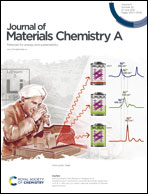A metal–organic framework derived electrical insulating–conductive double-layer configuration for stable lithium metal anodes†
Abstract
Controlling lithium dendrites growth and alleviating the volume expansion of lithium metal anodes are two key factors to develop high energy density lithium metal batteries. In this work, a planar Cu collector was modified by coating carbonized ZIF-67 as the bottom layer and ZIF-67 as the top layer to form an insulating–conductive double-layer configuration of the electrode (denoted as ICDL/Cu). Due to the insulating properties and high specific surface area of ZIF-67, lithium can be homogeneously deposited on the bottom layer through the top layer. The bottom layer carbonized ZIF-67 with lithiophilic Co nanoparticles and porous polyhedron are conducive to homogeneous deposition of lithium with reduced local current density. Such a porous structure ensures a low volume expansion during the lithium plating/stripping process. The symmetrical cell of ICDL/Cu–Li achieves a long cycling lifetime (more than 1100 h) with a low voltage hysteresis (11 mV) at 1 mA cm−2 for a plating/stripping capacity of 1 mA h cm−2. As a proof of concept, full cells based on ICDL/Cu–Li‖LiFePO4 deliver excellent rate performance and cycling stability compared with the bare Li‖LiFePO4 one, indicating that the unique ICDL configuration is promising for practical applications.



 Please wait while we load your content...
Please wait while we load your content...